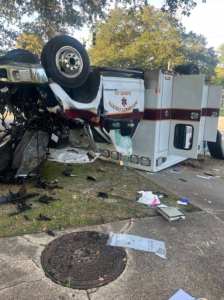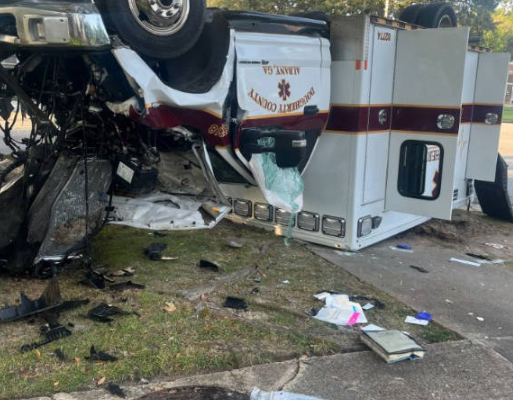8 Injured, Including Newborn Child, in Ambulance Rollover Crash
Accidents involving ambulances are among the most alarming types of roadway collisions. Unlike standard traffic mishaps, these crashes often involve patients who are already in fragile condition, as well as medical personnel trying to provide lifesaving care. Such was the case in a tragic rollover incident that left eight people injured, including a newborn child whose presence in the ambulance turned a routine emergency transport into a nightmarish ordeal.
The Crash and Its Immediate Impact
The crash occurred during what should have been a controlled and careful transport. The ambulance, carrying a newborn, the baby’s mother, two medical professionals, and a driver, was traveling with emergency lights activated. Early reports suggest the vehicle was en route to a hospital when it suddenly lost control, veered off the road, and rolled multiple times before coming to a stop on its side.
Witnesses at the scene described a terrifying sight. One bystander reported hearing the wail of sirens before noticing the flashing lights tipping and then disappearing as the vehicle overturned. Within seconds, motorists nearby rushed to assist, prying open the rear doors to reach those trapped inside. The chaotic scene quickly filled with cries, sirens from additional responding units, and the realization that those who usually render aid had themselves become victims.
When first responders arrived, they discovered eight injured individuals. The most vulnerable, of course, was the newborn, who had been secured in a small transport carrier. Though the infant suffered injuries, emergency personnel were able to stabilize the child before rushing them to the nearest hospital. The child’s mother sustained multiple bruises and a fractured arm. The paramedics and EMTs inside the ambulance suffered cuts, concussions, and in some cases more serious trauma from being tossed within the vehicle’s interior. Even the driver, who was wearing a safety belt, was not spared and reportedly sustained rib injuries and lacerations.
Why Ambulance Crashes Are So Dangerous
Ambulances are designed to carry both patients and equipment. Inside, cabinets, medical supplies, oxygen tanks, and heavy machinery can become dangerous projectiles when a vehicle overturns. Unlike standard passenger cars, ambulance occupants—particularly paramedics—are often not buckled in because they are administering care. This reality makes rollover crashes particularly severe, since medical staff can be thrown violently around the cabin.
According to transportation safety studies, ambulance crashes cause hundreds of injuries each year in the United States alone. While they represent a small fraction of overall road accidents, their consequences are disproportionately high because of who is inside: patients who are already in distress, healthcare professionals, and occasionally family members accompanying loved ones.
Investigating the Cause
Authorities have not yet released a final determination of what caused the rollover. Preliminary findings suggest the ambulance may have swerved to avoid another vehicle that failed to yield. Emergency vehicles with sirens activated are granted the right of way under traffic laws, but not all motorists respond appropriately. Drivers sometimes panic, freeze, or make sudden moves that can inadvertently place ambulances at risk.
Another possibility under investigation is road conditions. At the time of the crash, reports indicated the roadway was slick due to recent rainfall. High-speed turns or abrupt maneuvers in such conditions could lead to loss of control. Investigators are also examining whether the ambulance itself had any mechanical issues—such as brake problems or tire blowouts—that might have contributed.
Human Stories from the Crash
Beyond the statistics and mechanics, the human toll is deeply felt. The newborn, barely days into life, experienced trauma that no one could have anticipated. The baby’s family, already navigating the stress of medical care, now faces the emotional burden of recovery from a traffic accident.
The paramedics involved are also central to this story. These are professionals who dedicate their lives to saving others, often putting themselves in harm’s way. Ironically, their willingness to serve placed them directly in danger during the rollover. One of the injured EMTs reportedly told colleagues afterward, “We always prepare to help the injured—we never imagine being the ones who need saving.”
Local hospitals reported that while injuries ranged from minor to serious, all eight individuals were in stable condition after treatment. The quick response of nearby motorists and additional EMS crews is credited with preventing the crash from becoming a greater tragedy.
Community Reaction
News of the incident spread quickly through the community. For many, the image of an overturned ambulance symbolized both vulnerability and resilience. Social media posts poured in, with residents expressing gratitude that no lives were lost while offering prayers for the newborn’s recovery.
Community leaders praised the bystanders who intervened. “Their bravery demonstrates the best of our community spirit,” one city official said. “When seconds mattered, ordinary people stepped up to do extraordinary things.”
Broader Safety Concerns
This crash also reignites the debate about how to improve safety for ambulances and emergency personnel. Some experts argue for better vehicle design, including restraints that allow paramedics to remain safely secured while still performing basic tasks. Others call for advanced driver training programs that emphasize defensive maneuvers in unpredictable traffic conditions.
There is also discussion around public awareness. Many drivers are uncertain about how to react when they hear sirens approaching. Some pull to the left instead of the right, some stop suddenly in the middle of intersections, and others ignore the signals altogether. Campaigns reminding motorists of the proper procedures could help reduce risky situations for emergency vehicles.
Moving Forward
For now, the focus remains on healing. The newborn child remains under close medical observation, with doctors optimistic about recovery. The mother and other family members are receiving both medical and emotional support. Paramedics and EMTs injured in the crash are expected to return to duty after rehabilitation, though the psychological impact of the event may linger long after the physical wounds have healed.
Authorities will continue their investigation, and depending on findings, there may be new safety recommendations issued. Insurance adjusters and hospital administrators are also evaluating the financial implications, as ambulance crashes often result in costly medical bills, liability claims, and equipment losses.
Conclusion
The ambulance rollover that left eight injured—including a newborn child—serves as a sobering reminder of the fragility of both life and the systems designed to protect it. While ambulances symbolize safety and hope, they are not immune to the dangers of the road. This incident underscores the need for heightened caution from all drivers, improved safety protocols for emergency personnel, and continued efforts to reduce roadway hazards.
Most importantly, it highlights the resilience of those involved: the baby who survived despite vulnerability, the medical professionals who endured injuries while doing their jobs, and the community that rallied in response. In tragedy, moments of humanity shine through, reminding us why vigilance and compassion matter both on and off the road.

